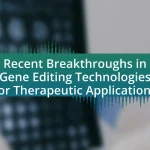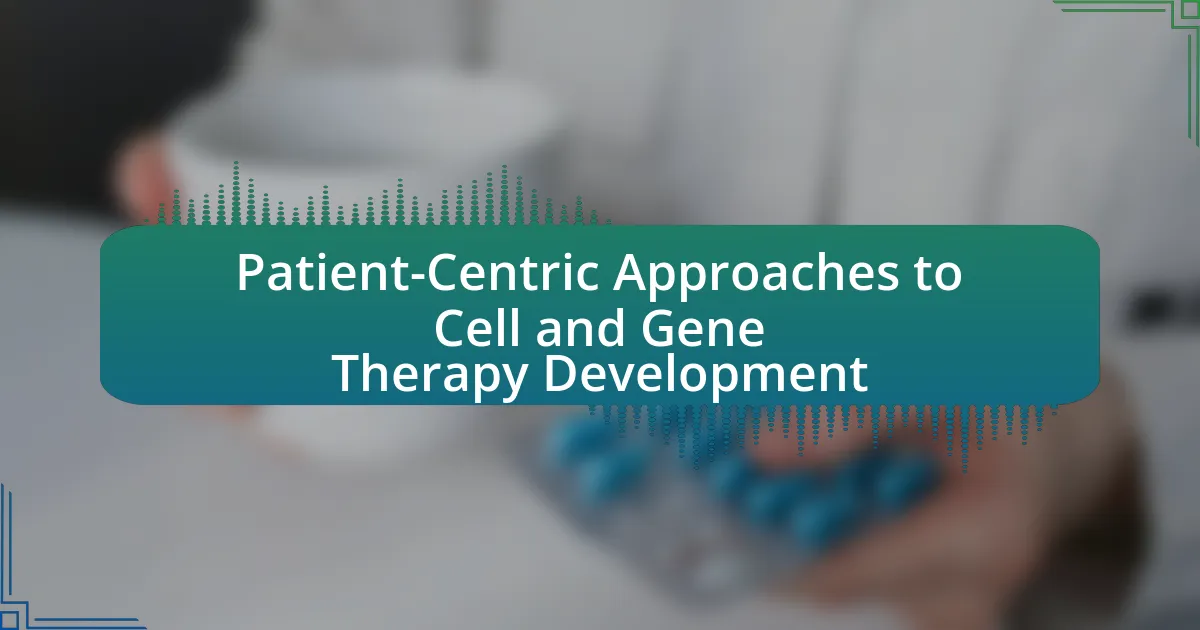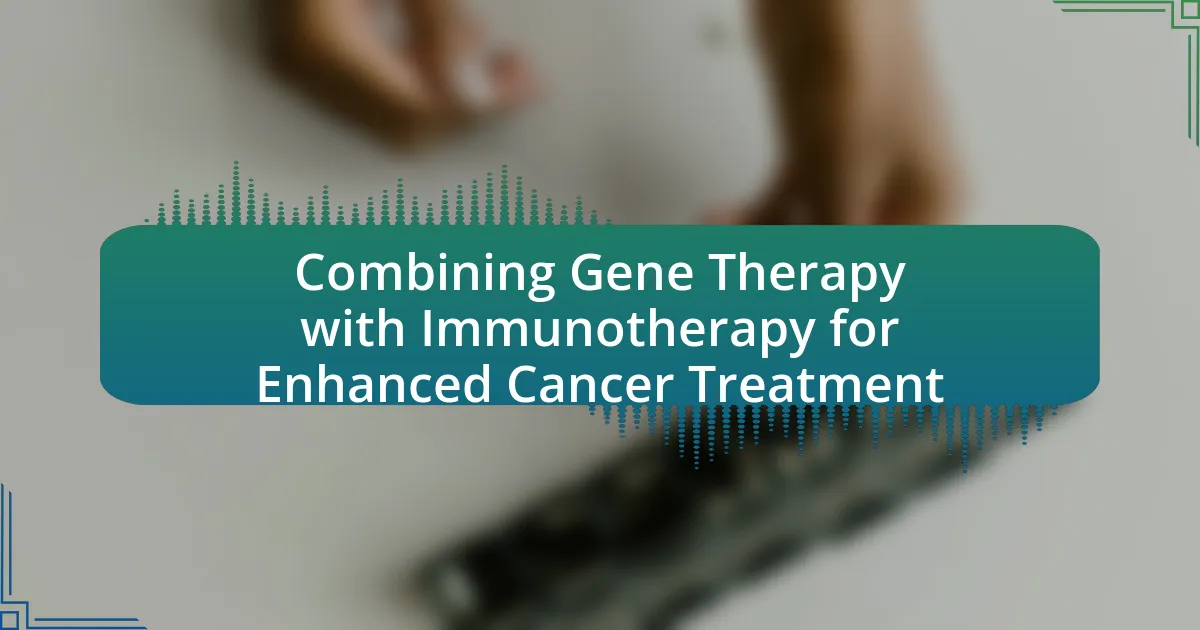Nanotechnology plays a pivotal role in enhancing gene delivery systems by facilitating the development of nanoscale carriers that improve the efficiency and specificity of gene transfer. Key nanomaterials such as liposomes, dendrimers, and nanoparticles are utilized to encapsulate genetic material, protect it from degradation, and enable targeted delivery to specific cells. The article explores how these nanocarriers enhance gene stability, release mechanisms, and therapeutic applications, particularly in gene therapy and cancer treatment. Additionally, it addresses the challenges of biocompatibility and regulatory issues, while highlighting future directions and innovations in the field that promise to advance personalized medicine and optimize gene delivery systems.
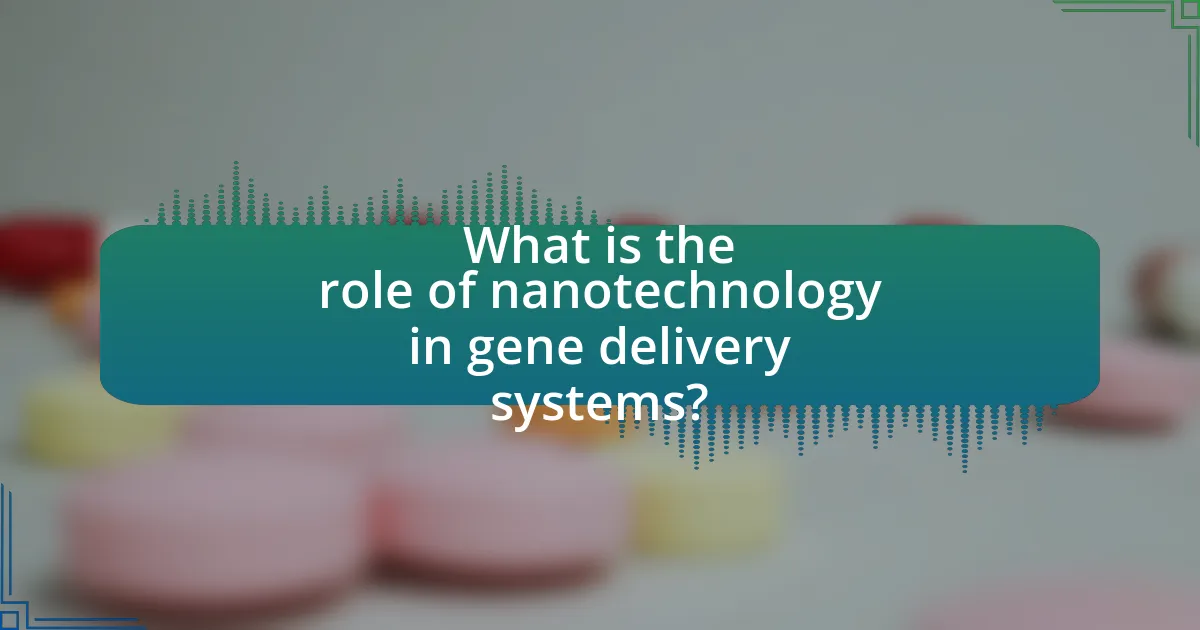
What is the role of nanotechnology in gene delivery systems?
Nanotechnology plays a crucial role in gene delivery systems by enabling the development of nanoscale carriers that enhance the efficiency and specificity of gene transfer. These nanocarriers, such as liposomes, dendrimers, and nanoparticles, can encapsulate genetic material, protect it from degradation, and facilitate its transport across cellular membranes. Research has shown that using nanotechnology can improve the targeting of specific cells, thereby increasing the therapeutic efficacy of gene therapies. For instance, studies have demonstrated that nanoparticles can be engineered to bind to specific receptors on target cells, leading to more effective gene delivery and reduced off-target effects.
How does nanotechnology improve the efficiency of gene delivery?
Nanotechnology improves the efficiency of gene delivery by enabling the development of nanoscale carriers that enhance the stability, targeting, and release of genetic material. These carriers, such as liposomes, dendrimers, and nanoparticles, can encapsulate DNA or RNA, protecting them from degradation in biological environments. For instance, studies have shown that lipid-based nanoparticles can increase cellular uptake by facilitating endocytosis, leading to higher transfection rates. Additionally, nanotechnology allows for the functionalization of carriers with ligands that target specific cell types, improving the precision of gene delivery. Research published in “Nature Nanotechnology” by Zhang et al. (2020) demonstrated that targeted nanoparticles significantly increased gene expression in specific tissues compared to non-targeted systems, highlighting the effectiveness of nanotechnology in enhancing gene delivery systems.
What are the key nanomaterials used in gene delivery systems?
Key nanomaterials used in gene delivery systems include liposomes, dendrimers, polymeric nanoparticles, and inorganic nanoparticles. Liposomes are lipid-based carriers that encapsulate genetic material, enhancing cellular uptake. Dendrimers are branched macromolecules that provide a high surface area for drug loading and functionalization, facilitating targeted delivery. Polymeric nanoparticles, made from biodegradable polymers, allow for controlled release and protection of nucleic acids. Inorganic nanoparticles, such as gold and silica nanoparticles, offer stability and can be engineered for specific targeting. These materials have been extensively studied for their effectiveness in improving gene delivery efficiency and specificity.
How do these nanomaterials enhance gene stability and release?
Nanomaterials enhance gene stability and release by providing protective environments for genetic material and facilitating controlled release mechanisms. These materials, such as liposomes, dendrimers, and nanoparticles, encapsulate DNA or RNA, shielding them from enzymatic degradation and environmental factors that could compromise their integrity. For instance, studies have shown that lipid-based nanoparticles can significantly improve the stability of mRNA by preventing its degradation in biological fluids, thus enhancing its therapeutic efficacy. Additionally, nanomaterials can be engineered to respond to specific stimuli, such as pH or temperature changes, allowing for the targeted release of genetic material at desired sites within the body, which optimizes gene delivery and expression.
What are the different types of nanocarriers used in gene delivery?
The different types of nanocarriers used in gene delivery include liposomes, polymeric nanoparticles, dendrimers, and inorganic nanoparticles. Liposomes are spherical vesicles that encapsulate genetic material, enhancing cellular uptake and protecting DNA from degradation. Polymeric nanoparticles are made from biodegradable polymers, allowing for controlled release and targeted delivery of genes. Dendrimers are branched macromolecules that can carry multiple gene copies and facilitate cellular entry due to their surface functionalization. Inorganic nanoparticles, such as gold or silica nanoparticles, can also be utilized for gene delivery, providing stability and the ability to be functionalized for specific targeting. These nanocarriers have been extensively studied for their effectiveness in improving gene delivery efficiency and specificity.
What are liposomes and how do they function in gene delivery?
Liposomes are spherical vesicles composed of lipid bilayers that can encapsulate drugs or genetic material. In gene delivery, liposomes function by encapsulating nucleic acids, such as DNA or RNA, protecting them from degradation and facilitating their transport into target cells. This is achieved through the fusion of liposomes with cell membranes, allowing the release of the genetic material into the cytoplasm. Studies have shown that liposomes can enhance the efficiency of gene transfer, as evidenced by their use in clinical applications like mRNA vaccines, where lipid nanoparticles have been pivotal in delivering genetic instructions for protein synthesis.
How do polymeric nanoparticles contribute to gene delivery?
Polymeric nanoparticles enhance gene delivery by providing a controlled and efficient means of transporting genetic material into target cells. These nanoparticles can encapsulate nucleic acids, protecting them from degradation and facilitating cellular uptake through endocytosis. Studies have shown that polymeric nanoparticles can be engineered to improve targeting specificity and release profiles, which increases the efficacy of gene delivery. For instance, research published in the journal “Molecular Therapy” demonstrates that cationic polymeric nanoparticles significantly improve the transfection efficiency of plasmid DNA in various cell types, highlighting their role in advancing gene therapy applications.
What role do dendrimers play in enhancing gene delivery systems?
Dendrimers play a crucial role in enhancing gene delivery systems by serving as versatile carriers that facilitate the efficient transport of genetic material into target cells. Their branched, tree-like structure allows for high surface area and functionalization, enabling the attachment of various ligands and therapeutic agents, which improves cellular uptake and specificity. Studies have shown that dendrimers can form stable complexes with DNA or RNA, protecting the genetic material from degradation and promoting its release within the cellular environment. For instance, research published in the journal “Molecular Pharmaceutics” demonstrated that polyamidoamine (PAMAM) dendrimers significantly increased transfection efficiency in vitro compared to traditional delivery methods, highlighting their effectiveness in gene therapy applications.
What challenges does nanotechnology face in gene delivery?
Nanotechnology faces several challenges in gene delivery, including biocompatibility, targeting efficiency, and stability of the delivered genetic material. Biocompatibility issues arise when nanoparticles provoke immune responses or toxicity in the body, which can hinder their effectiveness. Targeting efficiency is critical, as nanoparticles must accurately deliver genes to specific cells without affecting healthy tissues; this precision is often difficult to achieve. Additionally, the stability of the genetic material during transport is a concern, as degradation can occur before reaching the target site. These challenges are supported by research indicating that only a fraction of nanoparticles successfully deliver their payloads to intended cells, highlighting the need for advancements in nanotechnology for effective gene therapy applications.
What are the biocompatibility concerns associated with nanocarriers?
Biocompatibility concerns associated with nanocarriers include potential toxicity, immune response, and long-term stability in biological systems. Nanocarriers can induce cytotoxic effects due to their size, surface properties, and material composition, which may lead to cell damage or death. Additionally, the immune system may recognize these nanocarriers as foreign entities, triggering an inflammatory response that can compromise their efficacy and safety. Studies have shown that certain nanocarriers can accumulate in organs, raising concerns about their long-term effects on human health. For instance, research published in the journal “Nanomedicine” highlights that the biodistribution and clearance of nanocarriers can vary significantly, impacting their biocompatibility and therapeutic outcomes.
How do regulatory issues impact the development of nanotechnology in gene delivery?
Regulatory issues significantly impact the development of nanotechnology in gene delivery by imposing stringent guidelines that govern safety, efficacy, and ethical considerations. These regulations can delay the approval process for new nanotechnology-based therapies, as developers must conduct extensive preclinical and clinical trials to demonstrate compliance with safety standards set by agencies like the FDA. For instance, the FDA’s 2014 guidance on the development of nanotechnology products emphasizes the need for comprehensive risk assessments, which can prolong the timeline for bringing innovative gene delivery systems to market. Additionally, regulatory uncertainty can deter investment in research and development, as companies may be hesitant to allocate resources to projects with unclear pathways to approval.
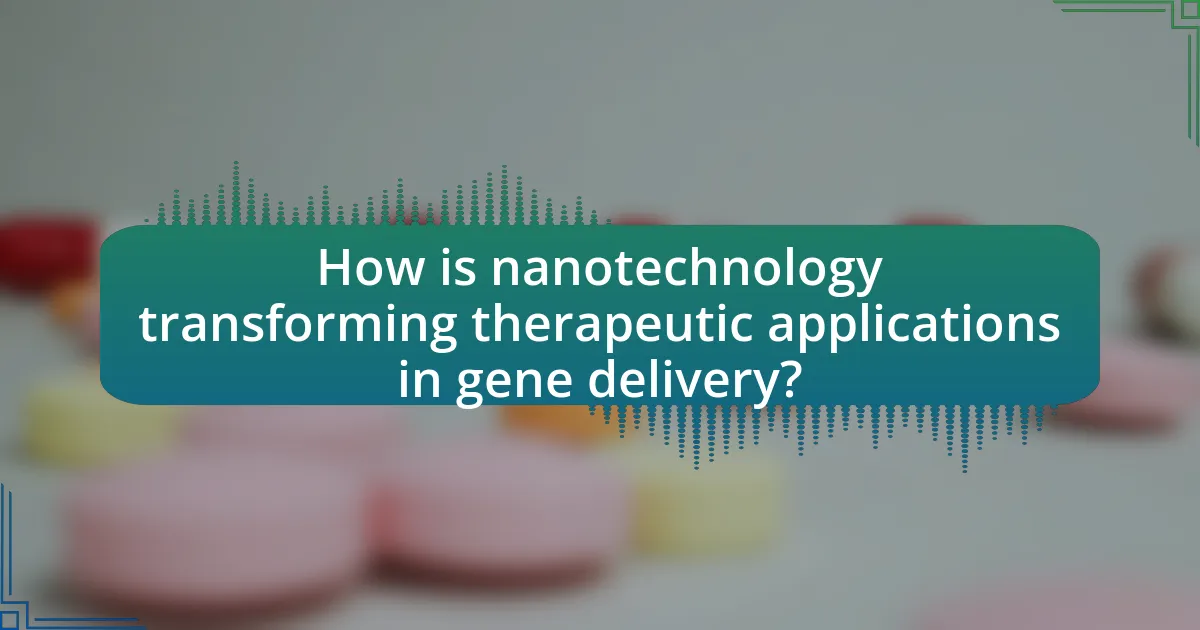
How is nanotechnology transforming therapeutic applications in gene delivery?
Nanotechnology is transforming therapeutic applications in gene delivery by enabling more efficient and targeted delivery of genetic material to cells. This advancement is primarily achieved through the development of nanoparticles, which can encapsulate DNA or RNA and protect them from degradation, thereby enhancing their stability and bioavailability. For instance, lipid nanoparticles have been successfully used in mRNA vaccines, demonstrating their ability to facilitate cellular uptake and promote effective gene expression. Additionally, nanotechnology allows for the modification of surface properties of these carriers, improving targeting capabilities to specific tissues or cells, which minimizes off-target effects and enhances therapeutic efficacy. Studies have shown that targeted delivery systems can significantly increase the concentration of therapeutic genes at the desired site, leading to improved treatment outcomes in conditions such as cancer and genetic disorders.
What are the potential therapeutic applications of enhanced gene delivery systems?
Enhanced gene delivery systems have potential therapeutic applications in gene therapy, cancer treatment, and vaccine development. These systems improve the efficiency and specificity of delivering genetic material to target cells, which is crucial for correcting genetic disorders, targeting cancer cells for destruction, and eliciting immune responses against pathogens. For instance, studies have shown that nanoparticles can effectively deliver CRISPR-Cas9 components to edit genes associated with diseases like cystic fibrosis and muscular dystrophy. Additionally, enhanced delivery systems can facilitate the administration of mRNA vaccines, as demonstrated during the COVID-19 pandemic, where lipid nanoparticles were used to deliver mRNA effectively, leading to robust immune responses.
How can nanotechnology improve cancer gene therapy outcomes?
Nanotechnology can improve cancer gene therapy outcomes by enhancing the delivery and targeting of therapeutic genes to cancer cells. Nanoparticles can be engineered to encapsulate genetic material, protecting it from degradation and facilitating its transport through biological barriers. For instance, studies have shown that lipid-based nanoparticles can increase the cellular uptake of plasmid DNA, leading to higher expression levels of therapeutic genes in tumor tissues. Additionally, targeted nanoparticles can be designed to bind specifically to cancer cell markers, ensuring that the gene therapy is delivered precisely where it is needed, which minimizes off-target effects and enhances therapeutic efficacy. Research published in “Nature Nanotechnology” by Peer et al. (2007) demonstrates that such targeted delivery systems can significantly improve the therapeutic index of gene therapies in preclinical models.
What role does nanotechnology play in treating genetic disorders?
Nanotechnology plays a crucial role in treating genetic disorders by enabling targeted and efficient delivery of therapeutic genes to specific cells. This technology utilizes nanoparticles to encapsulate genetic material, protecting it from degradation and facilitating its transport across cellular membranes. For instance, studies have shown that lipid-based nanoparticles can enhance the delivery of mRNA vaccines, demonstrating their potential in gene therapy applications. Additionally, research published in “Nature Nanotechnology” by Zhang et al. (2020) highlights how nanocarriers can improve the bioavailability and efficacy of gene-editing tools like CRISPR, thereby offering new avenues for treating genetic disorders at the molecular level.
What advancements have been made in targeted gene delivery using nanotechnology?
Advancements in targeted gene delivery using nanotechnology include the development of nanoparticles that enhance the specificity and efficiency of gene transfer to target cells. Recent studies have demonstrated that lipid-based nanoparticles, polymeric nanoparticles, and inorganic nanoparticles can be engineered to improve cellular uptake and reduce off-target effects. For instance, a study published in the journal “Nature Nanotechnology” by Zhang et al. (2021) highlighted the use of functionalized gold nanoparticles that selectively bind to cancer cell receptors, significantly increasing the delivery of therapeutic genes while minimizing toxicity to healthy cells. Additionally, advancements in surface modification techniques have enabled the precise targeting of specific tissues, further enhancing the therapeutic potential of gene delivery systems.
How does targeted delivery improve treatment efficacy?
Targeted delivery improves treatment efficacy by ensuring that therapeutic agents are directed specifically to the intended cells or tissues, thereby maximizing their impact while minimizing side effects. This precision reduces the required dosage and enhances the therapeutic effect, as evidenced by studies showing that targeted nanoparticles can increase drug accumulation in tumors by up to 10-fold compared to non-targeted delivery methods. Additionally, targeted delivery systems can facilitate cellular uptake and improve the bioavailability of drugs, leading to more effective treatment outcomes in conditions such as cancer and genetic disorders.
What techniques are used to achieve targeted gene delivery?
Techniques used to achieve targeted gene delivery include liposomes, nanoparticles, viral vectors, and dendrimers. Liposomes encapsulate genetic material and can be modified with ligands for specific cell targeting, enhancing delivery efficiency. Nanoparticles, such as gold or silica nanoparticles, can be engineered to bind to specific receptors on target cells, facilitating uptake. Viral vectors, derived from viruses, exploit natural infection mechanisms to deliver genes specifically to host cells. Dendrimers, which are branched synthetic polymers, can be designed to carry genetic material and target specific cells through surface modifications. These techniques leverage nanotechnology to improve the precision and effectiveness of gene delivery systems.
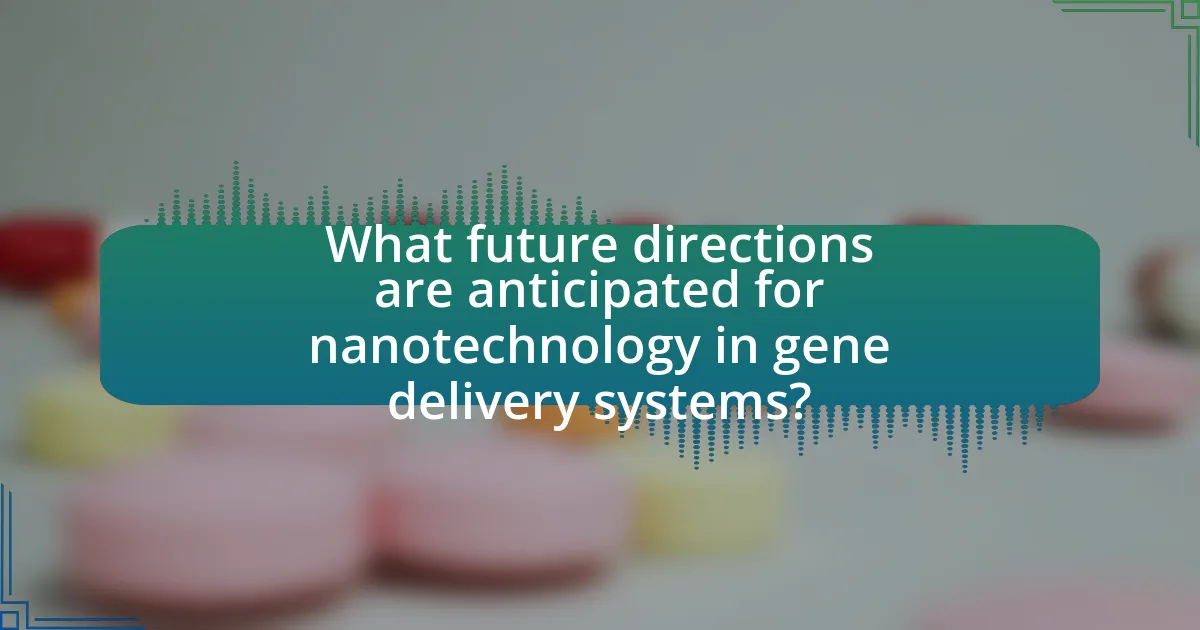
What future directions are anticipated for nanotechnology in gene delivery systems?
Future directions for nanotechnology in gene delivery systems include the development of more targeted and efficient delivery mechanisms, such as using nanoparticles that can specifically bind to certain cell types. This specificity is expected to enhance the therapeutic efficacy of gene therapies while minimizing off-target effects. Additionally, advancements in biocompatible materials and smart nanocarriers that respond to environmental stimuli, such as pH or temperature changes, are anticipated to improve the controlled release of genetic material. Research indicates that these innovations could lead to more effective treatments for genetic disorders and cancers, as evidenced by studies demonstrating improved delivery efficiency and reduced toxicity in preclinical models.
What innovations are on the horizon for nanocarriers in gene therapy?
Innovations on the horizon for nanocarriers in gene therapy include the development of targeted delivery systems, improved biocompatibility, and enhanced payload capacity. Targeted delivery systems utilize ligands or antibodies to direct nanocarriers specifically to diseased cells, minimizing off-target effects and increasing therapeutic efficacy. Improved biocompatibility is being achieved through the use of biodegradable materials and surface modifications that reduce immunogenicity. Enhanced payload capacity is being explored through the incorporation of advanced materials like dendrimers and liposomes, which can encapsulate larger amounts of genetic material. These advancements are supported by ongoing research demonstrating increased efficiency and safety in preclinical models, indicating a promising future for nanocarrier applications in gene therapy.
How might personalized medicine benefit from advancements in nanotechnology?
Advancements in nanotechnology can significantly enhance personalized medicine by enabling targeted drug delivery systems that improve treatment efficacy and reduce side effects. Nanoparticles can be engineered to deliver therapeutic agents directly to specific cells or tissues, allowing for precise treatment tailored to individual patient profiles. For instance, studies have shown that using lipid-based nanoparticles for gene delivery can increase the uptake of therapeutic genes in targeted cells, leading to improved outcomes in conditions like cancer and genetic disorders. This targeted approach minimizes systemic exposure and enhances the therapeutic index, demonstrating the potential of nanotechnology to revolutionize personalized medicine.
What role will artificial intelligence play in optimizing gene delivery systems?
Artificial intelligence will play a crucial role in optimizing gene delivery systems by enhancing the design and efficiency of delivery vehicles. AI algorithms can analyze vast datasets to identify the most effective nanoparticles for gene delivery, improving targeting accuracy and minimizing off-target effects. For instance, machine learning models can predict the interactions between nanoparticles and biological systems, leading to the development of more effective and safer gene therapies. Research has shown that AI-driven approaches can significantly reduce the time and cost associated with the development of gene delivery systems, as evidenced by studies demonstrating improved success rates in preclinical trials when AI is utilized for optimization.
What best practices should researchers follow when utilizing nanotechnology in gene delivery?
Researchers should prioritize biocompatibility, targeting efficiency, and controlled release when utilizing nanotechnology in gene delivery. Biocompatibility ensures that nanocarriers do not provoke adverse immune responses, which is critical for successful therapeutic applications. Targeting efficiency can be enhanced by modifying the surface of nanoparticles with ligands that bind specifically to target cells, improving uptake and minimizing off-target effects. Controlled release mechanisms, such as pH-sensitive or temperature-sensitive systems, allow for the precise timing of gene release, maximizing therapeutic efficacy while reducing potential toxicity. These practices are supported by studies demonstrating improved gene delivery outcomes and reduced side effects in various preclinical models.
How can researchers ensure the safety and efficacy of nanocarriers?
Researchers can ensure the safety and efficacy of nanocarriers by conducting thorough preclinical and clinical evaluations, including biocompatibility tests, pharmacokinetic studies, and toxicity assessments. These evaluations help identify potential adverse effects and optimize the delivery mechanisms of nanocarriers. For instance, studies have shown that specific surface modifications can enhance cellular uptake while minimizing cytotoxicity, as demonstrated in research published in the journal “Advanced Drug Delivery Reviews” by Allen et al. (2013), which highlights the importance of tailoring nanocarrier properties for effective gene delivery.
What are the key considerations for scaling up nanotechnology applications in gene delivery?
Key considerations for scaling up nanotechnology applications in gene delivery include biocompatibility, stability, and targeted delivery mechanisms. Biocompatibility ensures that nanocarriers do not provoke adverse immune responses, which is critical for patient safety and efficacy. Stability refers to the ability of nanocarriers to maintain their structure and function during storage and in biological environments, impacting their effectiveness in delivering genetic material. Targeted delivery mechanisms enhance the precision of gene delivery to specific cells or tissues, improving therapeutic outcomes and minimizing off-target effects. These factors are supported by research indicating that successful gene delivery systems must effectively navigate biological barriers while ensuring safety and efficacy in clinical applications.

